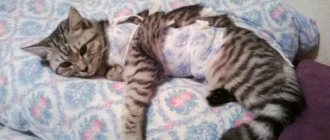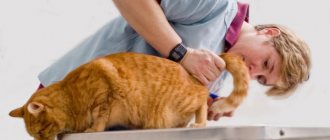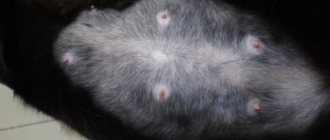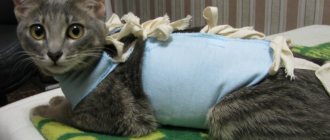Sterilization makes it easier and longer for cats to live, and reduces the risk of developing cancer pathologies. The operation is performed in different ways. The most traumatic type is an incision along the white line of the abdomen. The safest method is laparoscopy. Regardless of the method, complications may arise.
Often the operated pet has poor appetite or lack of it. If a cat does not eat after sterilization, this may be either normal or a sign of dangerous consequences.
About proper watering and feeding
As practice shows, approximately half of the normal amount of food and water can be given to a cat within 12 hours after returning from the clinic. But only if there are no separate instructions from your veterinarian.
In principle, an animal under 16 weeks of age recovers relatively quickly from surgery, and at this time it can be safely fed a “half” food norm. What to do when the animal doesn’t have much of an appetite? In this case, you can try to interest him by using a small amount of sugar (ideally maple) syrup.
To do this, take a cotton swab, lightly moisten it with a sweet solution and thoroughly wet your pet's upper lip with it. She will lick up the liquid and her appetite will probably be aroused. Feeding your cat will become much easier. Keep in mind that in cases where the animal is taken from the clinic in the evening or even at night, it will not have an appetite until the morning, and this is a completely normal physiological reaction of the body. Do not try to force water and food, the animal will probably eat on its own in the morning.
It is generally not advisable to leave anything other than a small volume of clean drinking water overnight. Offer the first portion of food in the morning, carefully observing your pet's behavior and possible pathological effects. If during this time (or after feeding) your cat begins to vomit or have profuse diarrhea, contact your veterinarian immediately, as there is nothing you can do at home.
When removing the ovaries and uterus, veterinarians use quite powerful and serious drugs. Therefore, in the postoperative period, under no circumstances give your animal any medications without first consulting with a specialist. The interaction of various drugs can lead to unpredictable consequences. If a specialist has prescribed any medications for your pet, be sure to strictly (!) follow all the veterinarian’s advice and recommendations.
Veterinarian advice
A sterilized cat may not eat for 2 days. Calorie reserves will be enough to provide the body with nutrients for this period.
Veterinarians recommend waiting and not force-feeding your pet. If after 2 days the cat does not have an appetite, it should be shown to a doctor.
Further advice from veterinarians is individual and depends on the diagnosis that will be given to the animal.
All information posted on the site is provided in accordance with the User Agreement and is not a direct instruction to action. We strongly recommend that before using any product, you must obtain a face-to-face consultation at an accredited veterinary clinic.
Caring for a cat after sterilization
The best option would be to keep the cat in the veterinary hospital for the entire period of recovery from anesthesia. But if your clinic does not provide such a service, or you cannot afford it for some reason, you will have to be with your cat all this time.
Typically, a post-operative blanket will be put on at the clinic, but if this is not done, you will need to put one on. Take a moment and study how it is tied (see Fig. 1), because in the future it will be more difficult to put it on and take it off - cats usually do not like blankets, and most likely, next time you will have to fight to put it on. After anesthesia, the animal’s body temperature drops by several degrees, so place the cat on the floor on a warm bedding (in no case, not on a sofa or table, since, when coming out of anesthesia, the cat will try to walk or crawl, and may fall and hit ) and make sure she is warm. You can place the animal next to the radiator or lean a heating pad against its back and cover it with a blanket. Periodically rub your cat's paws and ears to quickly restore normal blood circulation.
After some time, the cat will begin to move slowly, then try to walk or crawl. Don't leave her alone when this starts. The cat now has severely impaired coordination of movements, she may stagger from side to side, fall, and not understand where she is going
How and what to feed a cat after surgery?
The operation is performed under anesthesia. After waking up, the animal is desoldered from the syringe. It is better to offer food every other day, do not insist in case of refusal.
The preferred food on the first day is fermented milk products, porridge, boiled minced chicken. Subsequently, it is allowed to give low-fat meat broths, fruits and vegetables, boiled offal, and cereals. All ingredients are combined
It is especially important to ensure you drink plenty of fluids. The cat should have access to water around the clock
Modern dry food manufacturers produce special food for sterilized cats. They contain all the necessary microelements and immunostimulants.
Modern dry food manufacturers produce special food for sterilized cats.
It is strictly forbidden to give during the postoperative period:
- fish;
- semolina, oatmeal;
- full-fat milk, sour cream, cream;
- fried food;
- smoked meats, sausages.
Be sure to read:
How long to wear a blanket after sterilizing a cat, after how many days to remove it
Owners should be concerned about the following consequences of sterilization:
- lethargy and apathy;
- impaired coordination of movements;
- excessive thirst;
- unnatural posture when the pet is lying down;
- desire to hide, photophobia.
The animal’s need for fertilization should also be of concern. This is possible with incomplete castration, when the ovaries continue to function, but the cat cannot become pregnant. Nevertheless, she wants to.
Sometimes after sterilization, cats begin to mark their territory. This is caused rather by psychological reasons: this is how they assert themselves, because the reproductive instinct has been lost. This habit may go away over time, otherwise the animal will have to be weaned off it.
If a pet meows loudly after surgery, she reports that she is in pain and uncomfortable.
The cat has been sleepy and very lethargic for a long time
Very often, a cat does not eat well after sterilization, and is also in a lethargic and drowsy state, and may vomit or feel sick. For some, this period may last until the stitches are removed. Your veterinarian should answer all questions about caring for your pet after surgery. It is also worth listening to all the advice in what condition your pet may be in.
But there are some points that should definitely be observed:
- Rest. First of all, your pet needs a quiet and peaceful place where she can sleep
- There should be no other animals nearby that could somehow affect your pet.
- Very often, after the operation, the animal begins to tremble and its body temperature drops; at such moments it is worth warming it up, after which it will return to its previous state.
There is no need to worry that your cat has become a little aggressive or lethargic after surgery, even if she was very active and friendly before. After recovery, your pet’s behavior will become the same.
What is important to pay attention to?
It is not recommended to leave a cat unattended near water bowls, mugs and other utensils with water. Basically, after sterilization, a cat drinks little, but animals still have situations of excessive thirst, so there are certain risks. After sterilization, the animal’s swallowing reflex is disrupted; it drinks water inaccurately , so it may choke. Or just fall asleep with your head falling into a bowl of water. In this case, the owner will need to monitor the pet’s behavior in order to prevent this from happening.
Rules for feeding a cat in the sterilization field by day
The veterinarians at the clinic will learn about feeding rules. This is especially true for the consistency and quantity of food, because food can put pressure on the walls of the abdominal cavity, the site of the operation.
Anesthesia slows down intestinal motility, which prevents the passage of undigested food. As a result, food ferments and rots, the cat suffers from gas formation, bloating, and poisoning.
Therefore, veterinarians recommend giving the animal its first food the day after surgery and ensuring it drinks plenty of fluids to avoid dehydration. Otherwise, the blood thickens, it stagnates in the chambers of the heart, and the blood supply slows down.
Sometimes this condition leads to death, the heart stops.
Rules for feeding a sterilized pet after surgery by day:
| Day | What to feed |
| First | The cat is given a lot to drink and is not insisted on feeding |
| Second | Give a portion of food not exceeding 1/3 of the standard portion. You should not give heavy food, since the animal cannot push after surgery. All products must be fresh so as not to harm a weakened body |
| Third | As a rule, on the 3rd day the pet itself asks for food. The portion is gradually increased, but should not exceed 130 g, since sterilized cats are prone to obesity The pet can fast even on the 3rd day, but at the same time she feels good: she is mobile and behaves as usual. In this case, owners do not need to worry. You can offer your pet another food or add a few drops of fish oil for appetite. It is necessary to monitor whether the cat went to the toilet or not. In some cases, she refuses to eat due to constipation. You need to lightly feel the stomach: if there is a lump, you can do an enema or give a laxative |
If your pet does not touch food on the 4th day, you should immediately contact a specialist. There are cases when an animal immediately after sterilization begins to eat normally, but on the 4-5th day it stops eating.
In such a situation, you need to measure body temperature, examine the mucous membranes, and look at the color of the suture. If the mucous membranes are pale and bluish, and the suture is red and purulent, the cat should be shown to a veterinarian.
Danger of dehydration
Water makes up 65% of a cat's total body weight. With its help, nutrients and oxygen are transported to the tissues of the body. If there is insufficient fluid supply, this process slows down, and the lack of oxygen leads to cell death and disruption of system function.
Dehydration leads to an increase in the concentration of toxic substances in the blood and urine, which negatively affects the functioning of the kidneys and liver. Without receiving the proper amount of moisture and oxygen, certain areas of the brain gradually begin to die, which is accompanied by nervous phenomena, loss of coordination, convulsions and paralysis.
General information about the procedure
Sterilization is an operation that results in the removal of the uterus and ovaries in females and testes in males. It would be more correct to call the procedure castration, however, to soften the perception of owners, the concept was replaced by the term sterilization. As you know, a fairly large number of owners vehemently oppose the sterilization of pets, but they are guided mainly by common myths.
Let's figure out what changes in the animal's behavior to expect immediately after surgery and after a long period of time. As part of the questions, it is worth touching on the myths that frighten inexperienced owners and make them refuse to castrate their pets.
This is an abdominal operation that is performed under general anesthesia. In large, modern veterinary clinics, the procedure is performed laparoscopically. The advantages of the laparoscopic method are that there is no suture; the uterus and ovaries are removed through two small punctures in the peritoneum. Since laparoscopic surgery is considered expensive, most owners opt for strip surgery.
To avoid serious complications, before sterilization, it is recommended that the cat be examined for heart, kidney and liver failure. Serious complications can be caused by immunodeficiency, exhaustion, dehydration and other disorders leading to suppressed immunity or slowed metabolism.
Complications after sterilization
Complications after sterilization in cats can occur quite rarely. They usually occur as a result of failure to comply with the necessary measures after surgery or in cases where the operation was performed by a non-professional doctor. Also, their presence may depend on the individual characteristics of the pet’s body.
The following unpleasant consequences of sterilization are identified:
- The presence of prolonged post-anesthesia hypothermia. If a cat lies motionless for a long time, and its ears and paws are cold, then in these cases it is necessary to check its body temperature. If its level is less than 37 degrees Celsius, then the animal must be placed on a warm heating pad, covered with any natural fabric and called a veterinarian;
- Signs of intra-abdominal bleeding. Be sure to carefully monitor the condition of the seam at first. If you detect traces of blood in the suture or vulva area, as well as abdominal pain or pale skin, you should immediately consult a doctor. This must be done immediately in order to have time to stop possible bleeding in the abdominal cavity. If internal bleeding is detected, the doctor will prescribe a second operation;
- Manifestations of postoperative hyperthermia. If the temperature is more than 39 degrees Celsius and lasts for three days, then in these cases you need to consult a veterinarian. But it is better to take your cat to a veterinary clinic for the necessary examinations;
- Sometimes there may be redness around the stitch, as well as swelling. If these phenomena are observed for 3-5 days, then this is not considered a deviation, but if no discharge appears from the wound area. After about 5 days, signs of redness and swelling begin to gradually disappear, but their complete disappearance occurs by the time the sutures are removed;
- In rare cases, a cat may develop a hernia after sterilization. This phenomenon occurs due to non-compliance with advice on caring for your pet after surgery;
- If your cat screams after being spayed, this may be a sign of severe pain and discomfort. This phenomenon is considered normal in the first days; pain usually subsides on the 3rd day. To alleviate your pet's condition, you can use painkillers for cats;
- Rotting of postoperative sutures. This can happen if the rules of hygiene and care after sterilization are not followed, as a result of which dirt can get into the seam area. This leads to the development of wound suppuration. In these cases, the animal must be shown to a veterinarian;
- Diarrhea or constipation in a cat after sterilization. Problems with bowel movements may be the result of anesthesia;
- After recovering from anesthesia, the pet may be lethargic and lack appetite;
- If a cat does not drink after sterilization, this is also due to the effect of anesthesia. Usually the condition returns to normal within the next day;
- If after sterilization the cat does not go to the toilet at all or does it with difficulty, then she can be given a laxative or 1 tablespoon of Vaseline oil;
- Many owners notice that their cat sleeps a lot after sterilization. At first, this condition is normal. Drowsiness after anesthesia can be observed for 12-18 hours. The main thing is to control the animal’s body temperature; it should be covered with a warm blanket. Be sure to consult your veterinarian;
- Breast enlargement or mastopathy. These manifestations may occur before or after surgery. Sterilization speeds up recovery and eliminates all symptoms of mastopathy. The main thing is to provide proper and balanced nutrition for your pet.
If you suddenly discover one or more conditions from the above list in your cat, you need to contact a veterinarian. You should not self-medicate, because it can cause serious harm to the animal’s health.
The main thing is to provide her with attention and full progress.
Anesthesia is the cause of lack of appetite
Cat after sterilization: care at home
During surgery, veterinarians use general anesthesia as it helps numb the surgical site. Another advantage of anesthesia is that the cat will not escape from the operating table and will not inflict even greater injuries or mutilation on itself.
But the effect of anesthesia after the operation does not go away without a trace, and the cat recovers from it for a long time: it may take a long time to wake up, breathe heavily, eat nothing and move unsteadily - and all this is the norm.
In rare cases, an animal can be in a comatose state for a week: refuse to eat, sleep constantly and practically not move. But all this goes away over time without additional help.
If a cat does not drink water after anesthesia, then this is also quite normal, since it may vomit after drinking water or food. Therefore, you should be patient, and very soon your pet will recover.
Sterilization of cats. Laparoscopy
At the age of 7-9 months, kittens become sexually mature and, therefore, they are ready to breed. Most cat owners have neither the time nor the desire to breed kittens and, therefore, many resort to such an operation as cat sterilization or its non-cavitary type - laparoscopy.
Sterilization (castration) of a cat is the deprivation of the animal's ability to reproduce through surgical intervention.
tubal ligation is currently an unpopular method of sterilizing cats, since this preserves estrus, the cat continues to attract cats, and there remains a high risk of uterine inflammation;
removal of the ovaries (oophorectomy) - during this operation, the doctor removes only the ovaries, leaving the uterus. The cat's estrus stops. The risk of polycystic ovary syndrome and mammary gland tumors is, of course, reduced, but inflammation of the uterus still remains a threat to the cat;
removal of the ovaries and uterus (ovariohysterectomy) is the most optimal operation from a medical point of view, which not only prevents unwanted pregnancy and elimination of estrus, but also minimizes or eliminates the occurrence of inflammation of the uterus, ovaries, mammary tumors, etc.
At what age should a cat be spayed?
Opinions differ about at what age one can be sterilized, since some veterinarians claim that this procedure can be carried out at any age (there is no difference when it is better to do it), while other veterinarians categorically insist on the operation at 4-6 months.
Most experts motivate sterilization before puberty by the fact that the procedure at a later age will prevent the cat from becoming pregnant, but will not change the purring behavior during sexual activity.
Source
Sterilization of a cat. Before and after.
12-14 hours before the operation, do not give the cat food, and about an hour before the operation, remove the water, since the stomach, intestines and bladder should be empty. Purchase 2 postoperative blankets in advance, make sure that there are no threads sticking out of them, since the cat can pull them out and swallow them.
Indications for the study
- Search for the primary tumor site when metastases are detected;
- Determination of the stage of the oncological process;
- Differentiated diagnosis of relapse and post-treatment changes;
- Monitoring the course of the disease, detecting relapse;
- Planning of radiotherapy and surgical manipulation;
- Planning a biopsy and finding the most aggressive area of the tumor.
Radiofrequency ablation of liver metastases
Medicinal support
All medications must be approved by a veterinarian!
Painkillers:
- Rimadyl (carprofen) – intravenously or subcutaneously at a dose of 4 mg/kg (equivalent to 1 ml/12.5 kg of weight) once a day;
- Tolfedine (tolfenamic acid) – 4 mg/kg once a day orally with food;
- Ketofen 1% (ketoprofen) – subcutaneously, intramuscularly or intravenously at a dose of 2 mg/kg (or 0.2 ml/kg) once a day and no longer than 3-4 days;
- Loxicom (meloxicam) – 0.1 mg suspension/kg orally on the first day once, 0.05 mg/kg on subsequent days.
Seam treatment products:
- Chlorhexidine 0.05% (aqueous solution) - water the seam through a dispenser or drip from above using a pipette until healing;
- Dioxidine 0.5% - use similarly to Chlohexidine;
- Veteritsin spray - spray the suture area 1-2 times a day before removal;
- Aluminum spray - spray on the seam every few days until healing;
- Chemi spray - treat the seam once a day until healing;
- Levomekol ointment - apply around the wound once a day, under a bandage.
Antibiotics:
- Sinulox (amoxicillin + clavulanic acid) – intramuscularly once a day at a dose of 0.5 ml/10 kg for 3-5 days;
- Amoxicillin 15% – subcutaneously or intramuscularly 1 ml/kg (in terms of 15 mg/kg) once for 5 days.
Proper nutrition
A speedy recovery for a pet after intoxication is impossible without following a proper diet. What to feed a cat after poisoning is a concern for every responsible owner. As a rule, after an illness the animal loses its appetite for a long time.
However, special attention should be paid to nutrition issues
Veterinarians recommend a 24-hour fasting diet after poisoning an animal. A therapeutic fast will help the body cleanse itself of toxic substances and restore digestive function.
Due to the fact that many toxic substances are highly soluble in fats, at first you should not give the animal food containing them. Only vegetable fats are allowed in small quantities. This issue is especially relevant when phosphorus-containing substances (usually pesticides) and rat poison enter the body. For the same reason, you should not feed your animal milk. In addition, fatty foods will slow down the recovery of the liver, which suffers from any poisoning of the body.
Therapeutic food for a cat after poisoning should be gentle on the digestive system. Experienced breeders recommend feeding your pet during the recovery period 3 - 4 times a day for 1.5 - 2 months after poisoning.
Congee
If intoxication has occurred due to eating poor quality food, then after a daily fasting diet the animal should be given rice water. It is prepared in water.
After 2 - 3 days, the pet can be offered viscous porridge based on rolled oats and pureed buckwheat. You should not feed a sick cat pearl barley, semolina, or corn porridge.
Gradually, you can add boiled vegetables (carrots, broccoli, pumpkin) to your diet. After 5-7 days, if the pet’s condition is satisfactory, lean poultry and rabbit meat can be introduced into the diet. The meat should be given boiled, in small pieces or crushed in a blender until pureed. Fatty fish, table food, and canned food are strictly contraindicated.
You can give your animal low-fat cottage cheese. You should abstain from milk, cheese, and sour cream for the first 2 to 3 days. It is useful to give low-fat kefir if there is no digestive upset.
If before poisoning the animal was fed with ready-made formulas, during the recovery period it is recommended to give super-premium medicinal food, for example, Hills I/D for food poisoning, Hills L/D for liver problems due to toxic substances or K/D, if the kidneys were damaged by poisoning.
In the Royal Canin food line, you can use the Gastro Intestinal composition, which ensures maximum digestive safety, as well as Hepatic food, which supports liver regeneration. A veterinarian will help you choose one or another medicinal food, taking into account the type and form of poisoning.
Cat food recommended for consumption after poisoning
Owners often note that after poisoning the cat does not eat. After severe intoxication, this phenomenon is often observed. If there is no appetite for 2-3 days, you should not force feed the animal, as this may provoke vomiting. If the general condition of the sick pet is weakened, it should be regularly taken to the veterinary clinic for the administration of intravenous nutrient solutions. For this purpose, infusions of 40% glucose solution and saline are used.
Description of research technology
The basis of the research technology is the study of tissue characteristics, structural and functional. Functional characteristics can be assessed through metabolism. Let's take the following example. We choose a substance that is necessary for all cells of the body. We mark it with a radioactive label, introduce it into the body and observe the places of its maximum accumulation.
Glucose is a universal substance in the human body. With the help of glucose, almost all tissues and cells are nourished. In malignant tumors, the greatest consumption occurs, since the growth and reproduction of tumor cells requires a lot of energy.
In a PET/CT scan, glucose is labeled with radioactive atoms with a short half-life. Once in the body, glucose actively accumulates in tissues with the most intense metabolism, i.e. in cancerous tumors.
The tag disintegrates, emitting energy in the form of gamma rays. A special device records this process. The data that the doctor receives creates a visual model showing the location of the tumor, its size and metastases.
Radioactive tracers accumulate only at the location of atypical cells; healthy tissues are not visualized.
When the doctor needs to examine both healthy and changed structures, CT comes to the rescue, allowing you to obtain a detailed picture with millimeter accuracy.
After data from both scanning systems is received, they are superimposed on each other, thereby achieving an image that gives a clear picture of the location of tumor foci.










